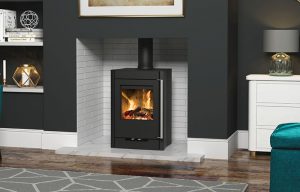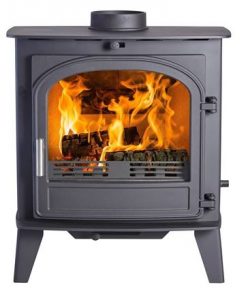Even though there are well in excess of 1 million wood-burning and multifuel stoves in the UK, have you ever sat back and wondered just what kind of technology is under the surface? Have you ever wondered how heat continues to seep into your room even when the fire is out? How primary, secondary and tertiary air flow systems work? Or do you just prefer to sit back, kick off your shoes and enjoy the deep seated heat that comes with the modern day wood-burning/multifuel stove?
Centuries-old stoves
The history books are littered with mention of basic stoves going back literally hundreds of years. The ability to burn wood and retain heat to keep you warm over a long period of time must have been the Holy Grail of life in the olden days. It was only in the 18th century that stove designs began to change into something similar to what we see today. Initially the stoves were seen as highly inefficient but over-time they have been reset focused and reset again to become some of the most efficient forms of heating available today.

Before we look at recent development it is worth pointing out that an open coal fire is only 30% efficient while some of the modern day multifuel/wood-burning stoves are in excess of 80% efficient. This is the level of fuel which is directly transferred into heat so stoves of today will lose around 20% of fuel in the process, while an open coal fire will lose around 70% between burning and pumping out heat into your room. Who would have guessed that?
Air wash systems
In the modern age there is an obsession with the environment and as such the make-up of wood-burning stoves and multifuel stoves has changed dramatically. The principle is still the same, burning fuel to create heat and minimising emissions. However, today we have primary, secondary and tertiary air supplies which make a massive difference to the efficiency of your stove.

The primary air supply traditionally enters your stove from underneath the body. This is the airflow which is needed to start your fire in the morning after which you can adjust the air vents for optimum burning. This is also a major tool in ensuring that your stove does not overheat therefore becoming less efficient and potentially damaging your flue.
The secondary air supply has perhaps the longest journey initially passing by the firebox, across the glass viewing area, and then into the firebox. By the time the secondary air supply is in the firebox it has been preheated and is used to burn off excess gas created in the primary process. The secondary air supply is also a useful means of ensuring that the glass viewing area remains clear at all times – ensuring that small particles do not build up on the surface of the glass.
Many modern stoves have a tertiary air supply which emerges from the back of the firebox and is immediately heated to extreme temperatures. This allows any remaining gases to be burnt again which create more heat and reduces the eventual level of emissions. This is a vital element of the clean burn systems available in many stoves today. The ability to burn, re-burning and burn again dramatically increases heat output and dramatically reduces gas emissions. Perfect!

Automatic control/smart systems
Who would have thought 20 or 30 years ago that new technology would allow you to literally communicate and control your wood-burning/multifuel stove using an app on your phone? The reality is that many new stoves offer the option to effectively preprogram your machine so it is at optimum heat output when you arrive home. Due to the installation of smart thermostats you can quite literally leave your stove to find its own optimum level which will increase heat output and reduce your fuel bills. These are very easy devices to use either as a stand-alone remote control or part of a new technology app on your phone.
As this technology continues to evolve there are new systems which allow you to monitor the heat output, fuel consumption and overall efficiency of your wood-burning and multifuel stove. You can compare and contrast the various variables under different weather conditions and different types of fuel, allowing you to optimise the way in which you use your stove.
Ecodesign regulations
The European authorities have been working on improved burn efficiency for wood-burning and multifuel stoves for some time. In 2022 the Ecodesign regulations come into play which will place a greater emphasis on stove manufacturers to create vastly more efficient machines. The target is to reduce particle emissions by up to 90% which is an ambitious target but one which has already been met by many new wood-burning/multifuel stoves. Yes, some stove manufacturers are already four years ahead of these regulations and using the Ecodesign stamp as an effective seal of approval for their clean burn stove products.

The Stove Industry Alliance (SIA) has been extremely supportive of the Ecodesign regulations allowing the industry to have a voice when talking to regulators. In many ways this has led to a bout of “common sense” with ambitious targets but ultimately reachable targets. Slowly but surely over the next few years you will see some of the less efficient stoves either upgraded or phased out. It is a little unfortunate that some of the headlines of late are bulking modern day stoves with their older (less efficient) counterparts when discussing excessive emissions. Hopefully, with the assistance of the SIA and the European regulators we will see a more sensible approach to regulations in the future.
Wider viewing areas
While not necessarily a new technology, wider viewing areas are certainly more commonplace today than they ever have been. After all, it is the flickering flames and the burning embers which draw your eyes to the firebox of a wood-burning/multifuel stove. The ability to watch through an extended viewing area and, in more and more cases, through side glass panels, just enhances the overall experience. It also allows your stove to emit a relaxing glow which can change the ambience of any room.
Use of soapstone casings
Those who have come across stoves which are essentially encased in soapstone could be forgiven for thinking this was purely for decorative purposes. It is smooth, looks the part and also gives a significant size boost to your stove. While not necessarily a “new technology” it is worth noting that soapstone is one of the most efficient materials to absorb, store and slowly emit heat. It can quite literally store the heat you have created for hours and slowly allow it to seep into your room, maintaining that magic temperature. Be warned, it is not all about the aesthetics!

Conclusion
On the surface it is easy to assume that the modern day wood-burning/multifuel stove has not necessarily shown great development over the last hundred years. However, if you scratch below the surface you will see a highly efficient machine, technologically advanced burn systems and efficiency ratings which blow open coal fires out of the water. The introduction of Ecodesign regulations in 2022 has been well received by the industry and indeed many new stoves today are already Ecodesign friendly.
Over the next few years we are likely to see various incentives to put old less efficient stoves out to grass and replace them with more efficient clean burn systems. This will take some time, there will need to be significant incentives, but in the long run any reduction in emissions should be welcomed by all parties.

